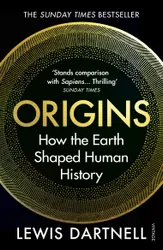This is a book about how the geology of the Earth has influenced and affected the development of human civilisations. It starts at the very beginning with the evolution of humans from tree-dwelling primates, and how the unique characteristics of the plains of Africa where our ancestors lived may have led to the development of those traits that make us human: walking bipedally, intelligence, and tool use. It also discusses how the environment in which we evolved was created, in terms of the movement of continental plates and their effect on the landscape and climate of that part of Africa. In fact, throughout this book, we learn a lot about the Earth’s history from a geological perspective, and how the movement of the continents has affected the climate, landscape, fertility of soil etc. All the effects on human development and civilisation are brought back to first principles in terms of the geology of the Earth, including those rocks from which we were first able to craft stone tools like the hand axe.
Unlike Revolutions That Made The Earth or Otherlands, this book doesn’t go into a huge amount of detail on the development of life before the emergence of humans, but it does cover the basics, especially where they’re relevant to human development.
At various times in Earth’s history, continents were joined together that are currently separated, and ice ages covered the planet in ice. Both of these factors allowed life to migrate between continents, including allowing humans to spread to other continents from Africa. From there, the book discusses how and why humans switched from a hunter-gatherer lifestyle to farming, and why civilisations developed at different rates in different areas. One factor in the development of farming was the availability of domesticable species. Eurasia had a distinct advantage over the other continents, because there were several native grasses that could be domesticated to provide food, and animal species that were useful for both food and physical labour, and this may be why the first civilisations emerged in Eurasia.
History is often written from the perspective of how human decisions affected the rise and fall of civilisations and empires. But this book makes the case that factors like geology, climate, flora and fauna have just as much, if not more, of an effect. For example, the invasions of parts of Europe and the Middle East from the Mongols were enabled by their herding lifestyle on the Steppe of central Asia, the availability of horses and their mastery of horse riding in battle. The book also discusses factors that led to the growth (or decline) of civilisations, and the path they took to the technologically advanced civilisations of today. These factors include the formation of metal deposits in the Earth, leading to the Bronze and Iron Ages, and the formation of coal and oil deposits millions of years ago that enabled the industrial revolution.
I found the discussion of the age of exploration particularly interesting. Navigators from Europe were trying to find ways to trade with (or take over) countries in the far east, and were attempting to sail around Africa to get there. Their progress was determined by their ability to find either favourable winds or helpful ocean currents going in the right directions to allow them to get there and back. The book explains why the Earth’s winds and ocean currents are the way they are, and how the sailors during this period of history were able, via a process of trial and error, to discover how to sail around Africa and back. The same principles applied when European navigators discovered and colonised the Americas.
This book is really well written and contains many good diagrams and maps to help explain the points made in the book. I learnt a lot about plate tectonics, and found it fascinating to think about how much human civilisation has been affected by the particular nature of Earth’s geology. I really enjoyed this book, and I think anyone interested in how the Earth has influenced human development will get a lot out of it.
